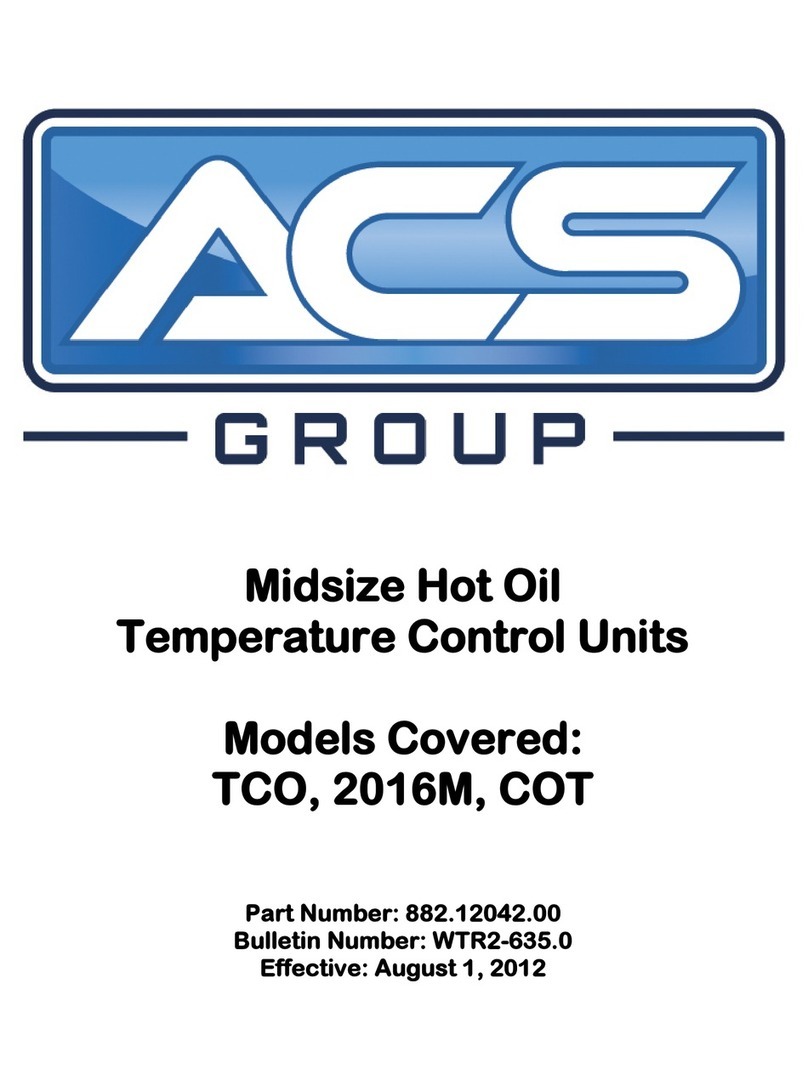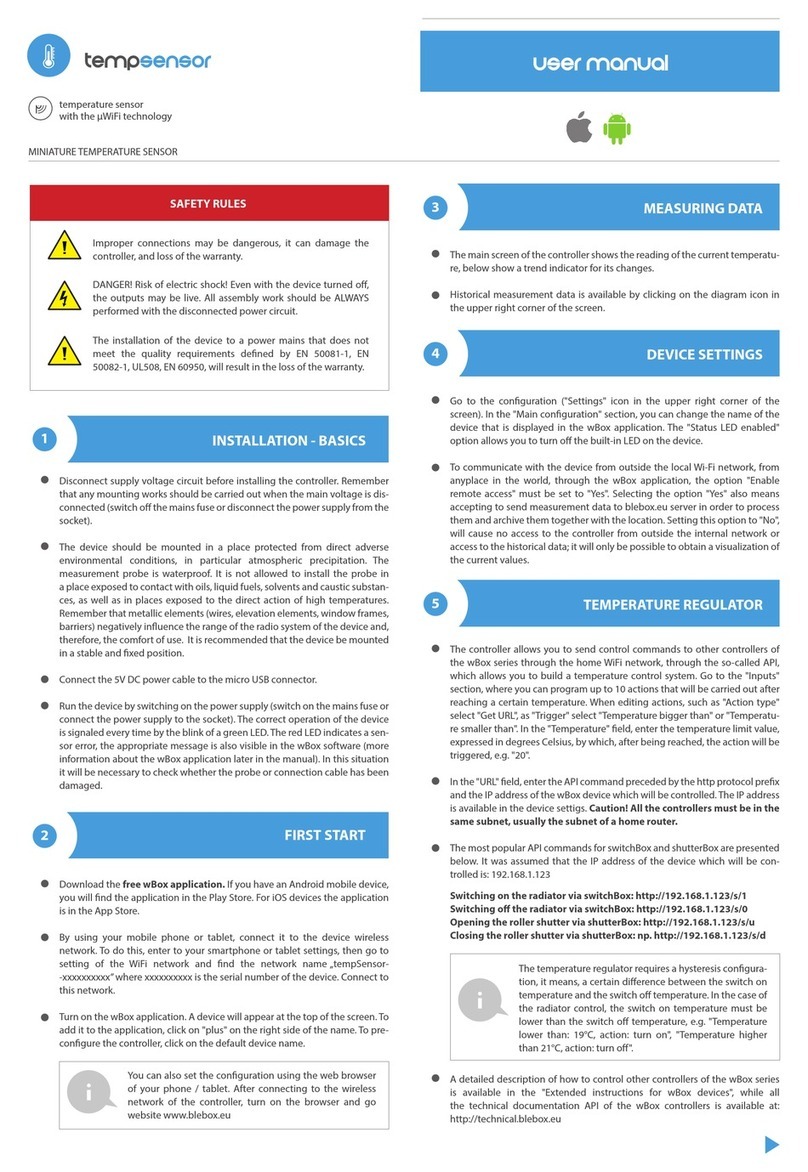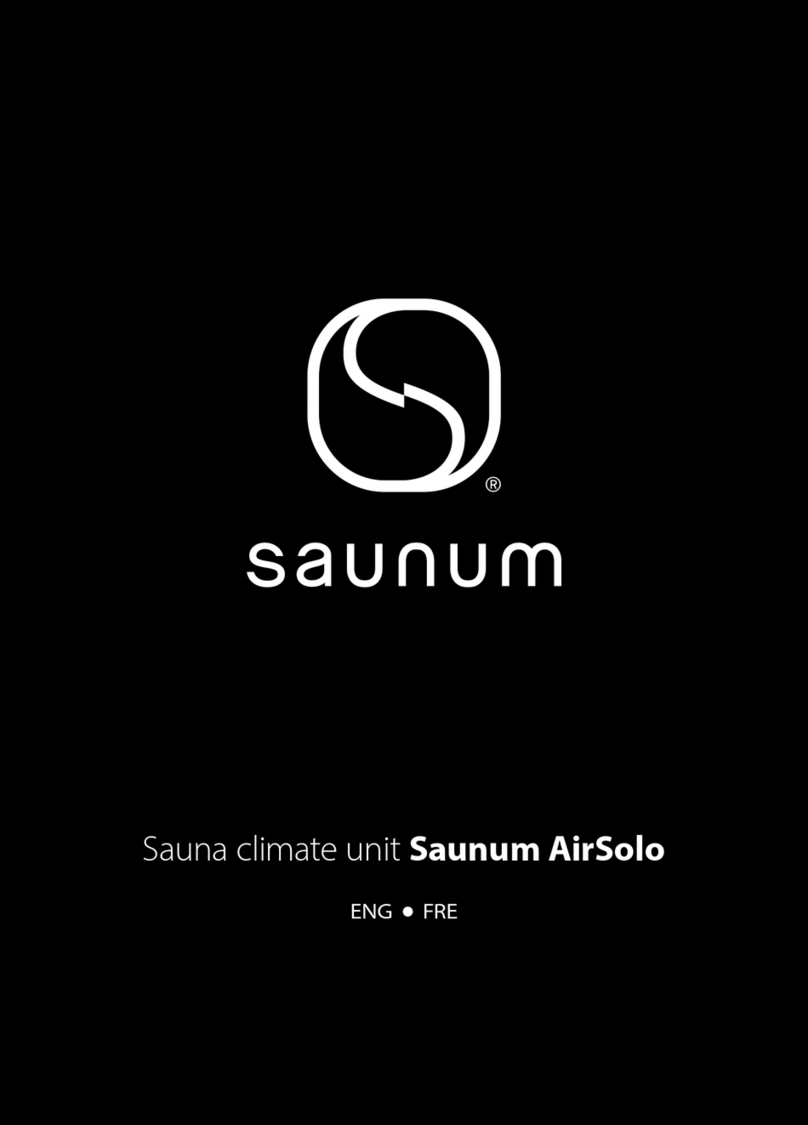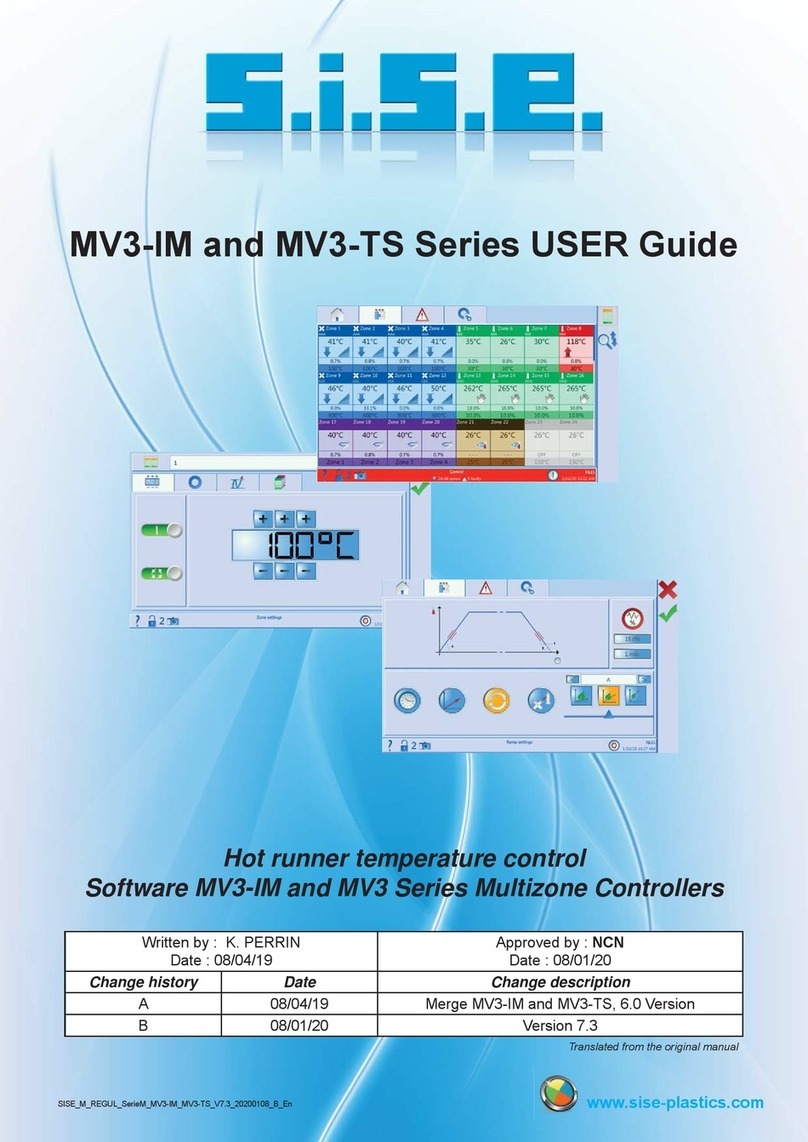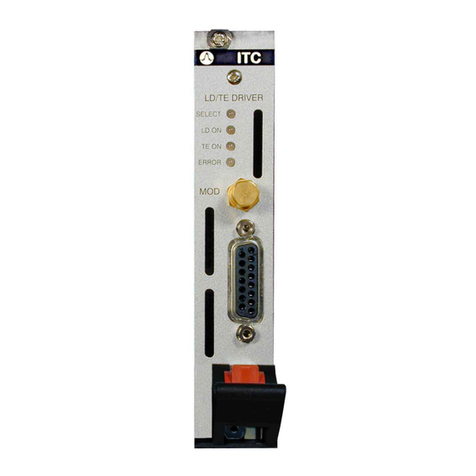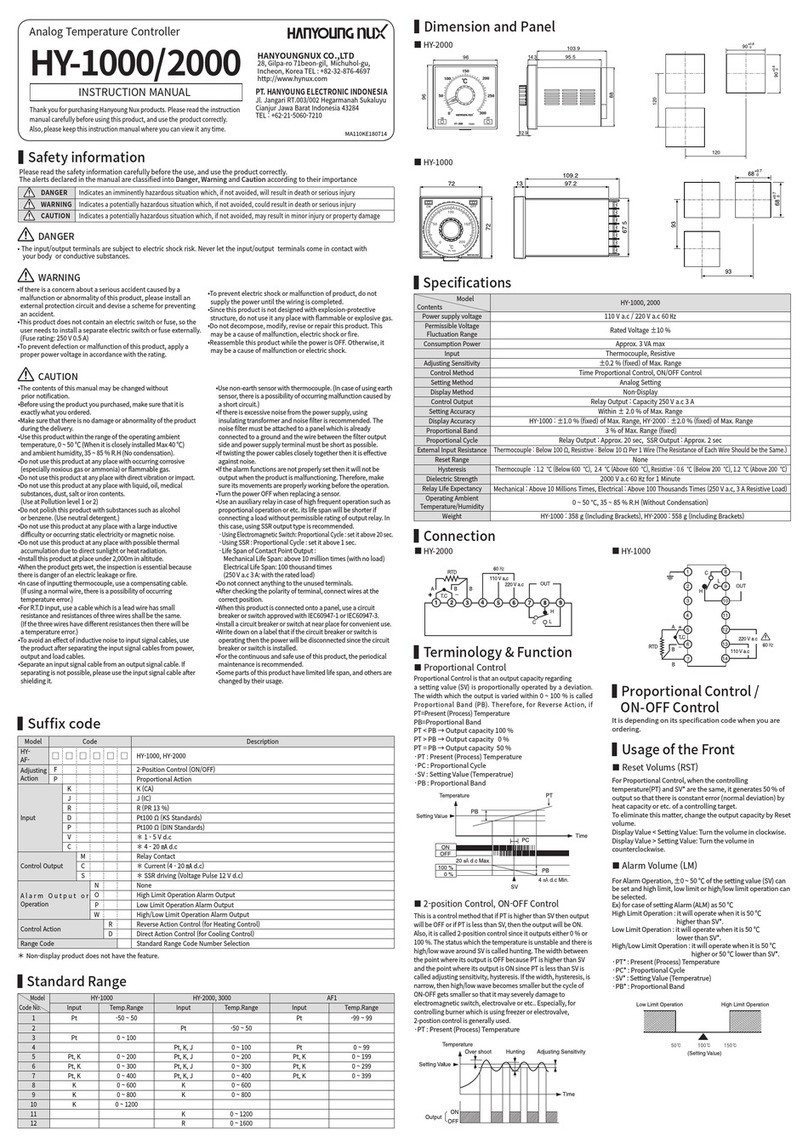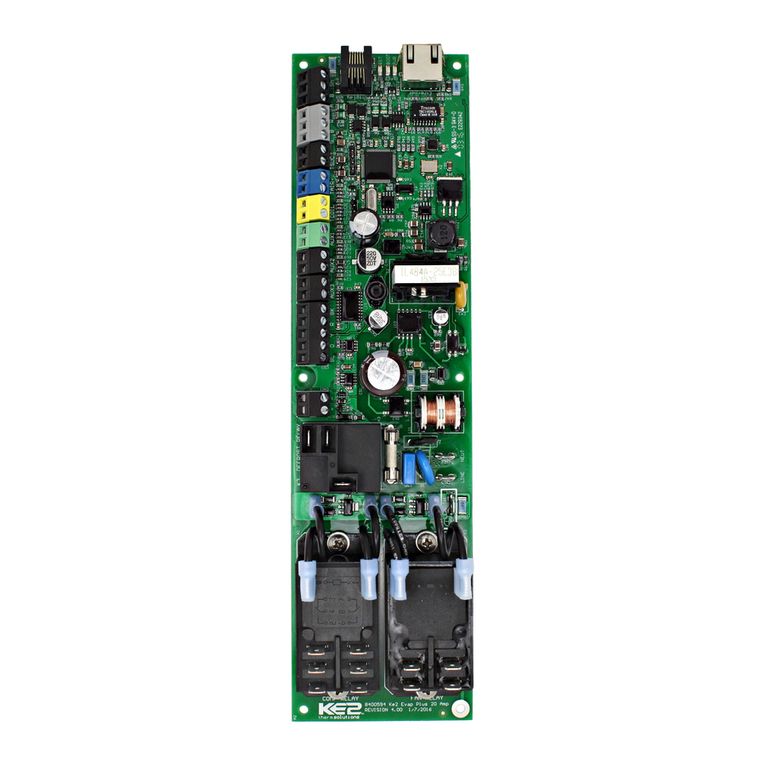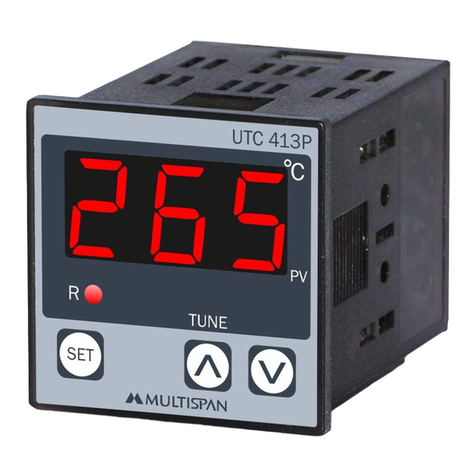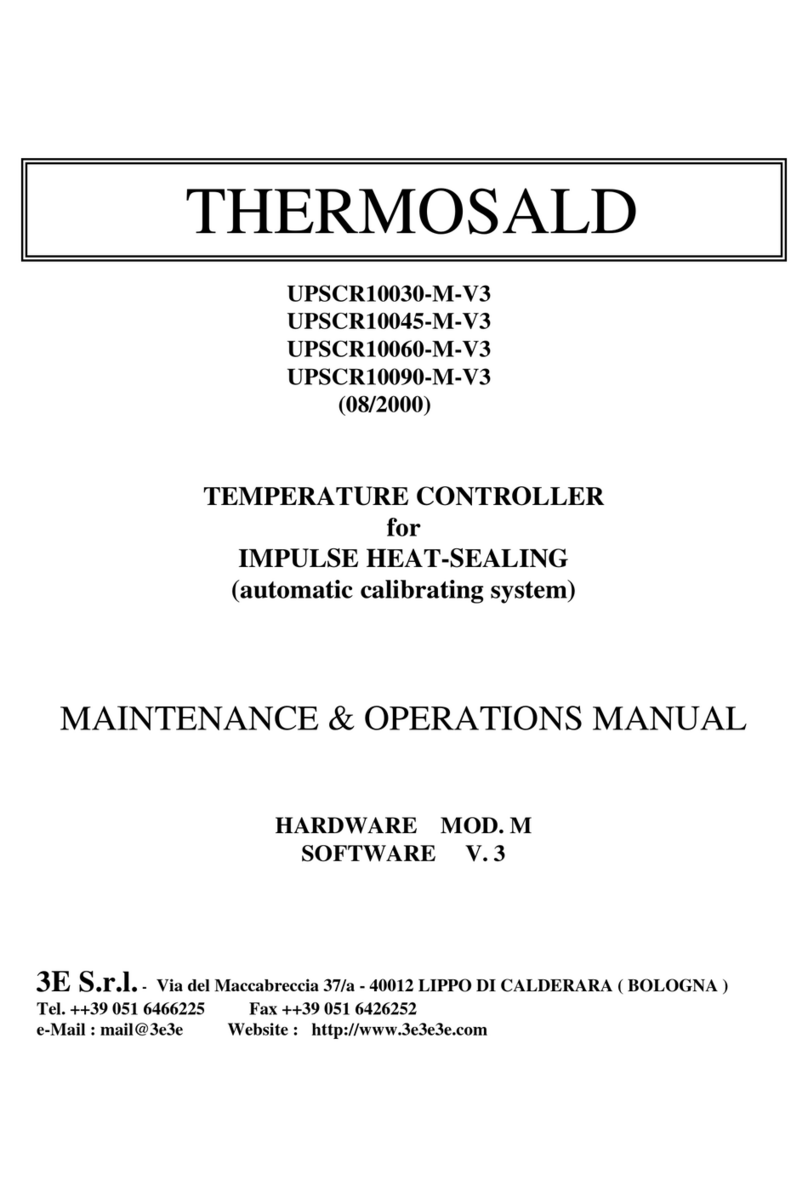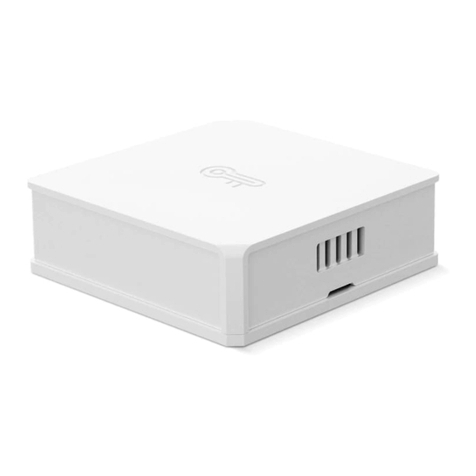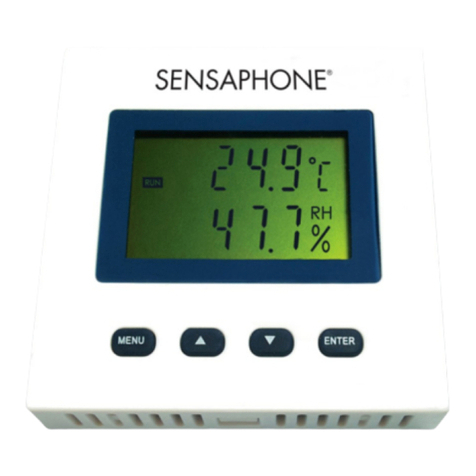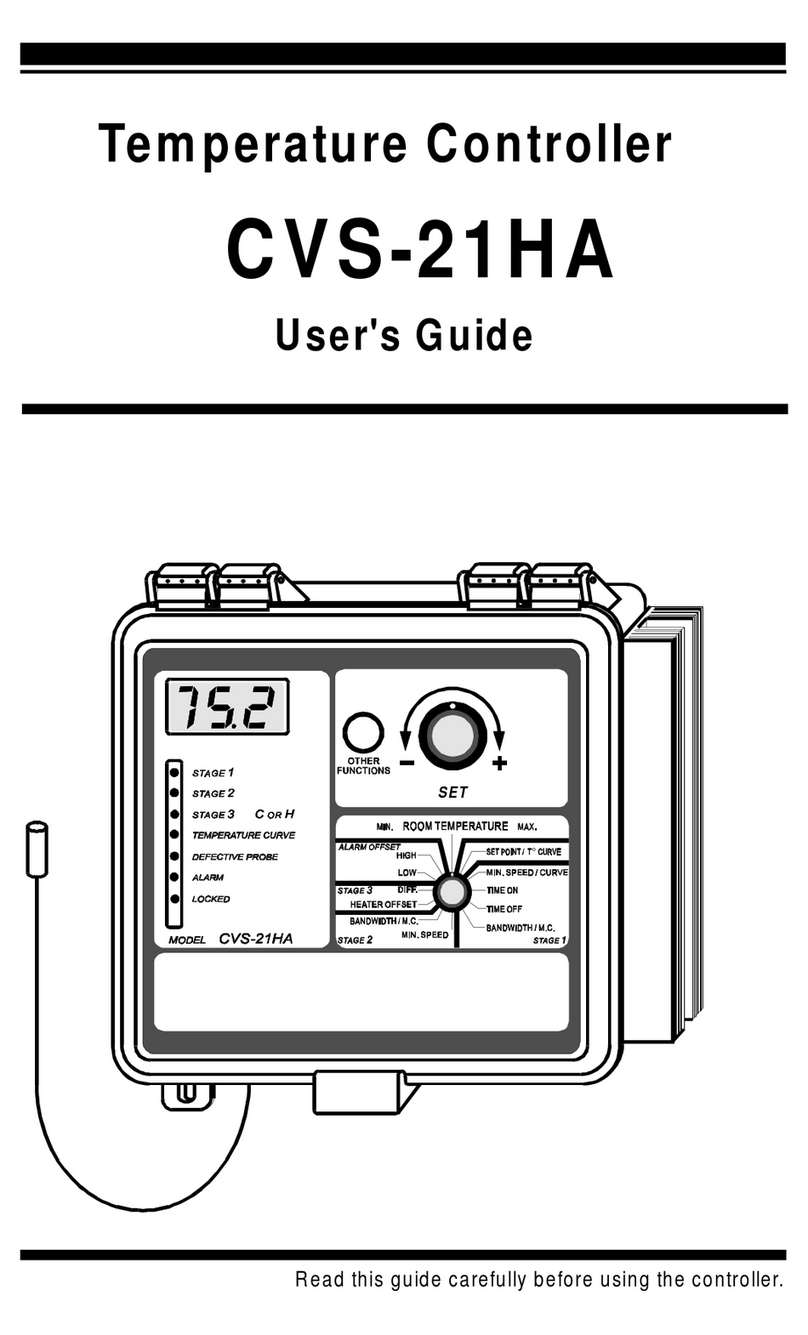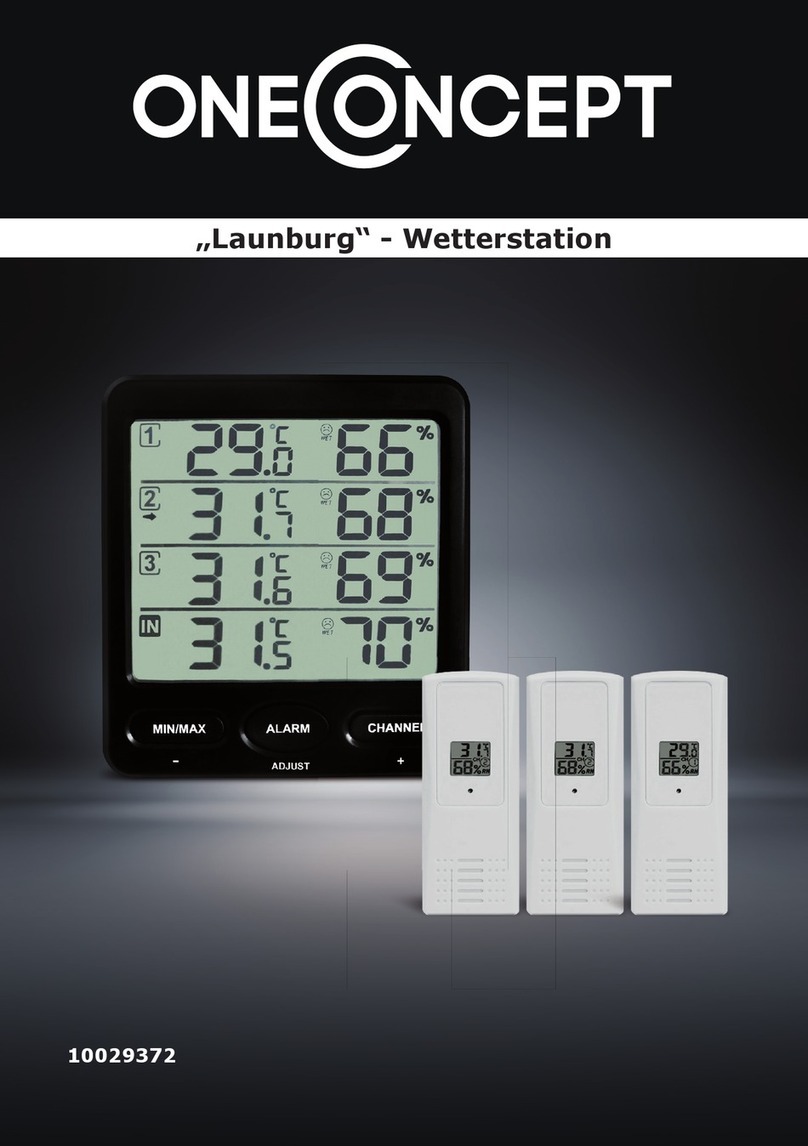ACS 3200 Series User manual

3200 Series
A
CS 3216 Operators Manual 1
3200 Series PID Temperature Controllers
ACS Custom Manual Issue 1.0
3216 Controllers
Issue 1 of this Handbook applies to software versions 2.09 and above for PID controller and includes:
•Remote Setpoint Input Option RCL
•Programmer Cycles
Contents
1. Installation and Basic Operation..........................................................................................................3
1.1 What Instrument Do I Have?................................................................................................................................. 3
1.2 What Firmware Do I Have?................................................................................................................................... 3
Firmware V2.09 (Modbus) Firmware V2.50 (SPI)............................................................................................. 3
What Instrument Do I Have?.............................................................................................................................................. 4
Order Code........................................................................................................................................................................... 4
2. Wiring .....................................................................................................................................................5
2.1 Terminal Layout 3216 Controller.......................................................................................................................... 5
3. Panel Layout...........................................................................................................................................6
3.1 Front Panel Layout................................................................................................................................................. 6
3.1.1 To Set The Target Temperature. .......................................................................................................................... 6
3.1.2 Alarms.................................................................................................................................................................. 6
3.1.3 Alarm Indication .................................................................................................................................................. 6
3.1.4 Auto, Manual and Off Mode................................................................................................................................ 7
3.1.5 To Select Auto, Manual or Off Mode................................................................................................................... 7
4. Operator Level 1 ....................................................................................................................................8
4.1.1 Level 1 Operator Parameters................................................................................................................................ 8
5. Operator Level 2 ....................................................................................................................................8
5.1 To Enter Level 2...................................................................................................................................................... 8
5.2 To Return to Level 1............................................................................................................................................... 8
5.3 Level 2 Parameters.................................................................................................................................................. 8
6. Access to Further Parameters...............................................................................................................9
6.1.1 Level 3.................................................................................................................................................................. 9
6.1.2 Configuration Level ............................................................................................................................................. 9
6.1.3 Selecting Recipes (Configuration Level) ............................................................................................................. 9
6.1.4 To Select Access Level 3 or Configuration Level................................................................................................ 10
6.2 Parameter lists......................................................................................................................................................... 11
6.2.1 To Choose Parameter List Headers...................................................................................................................... 11
6.2.2 To Locate a Parameter.......................................................................................................................................... 11
6.2.3 How Parameters are Displayed ............................................................................................................................ 11
6.2.4 To Change a Parameter Value.............................................................................................................................. 11
6.2.5 To Return to the HOME Display.......................................................................................................................... 11
6.2.6 Time Out .............................................................................................................................................................. 11
6.3 Navigation Diagram................................................................................................................................................ 12
7. Custom Scrolling Text ...........................................................................................................................12
Custom Configurations........................................................................................................................................................ 12
7.1.1 Master Parameter List .......................................................................................................................................... 13
8. Diagnostic Alarms..................................................................................................................................20
8.1.1 Out of Range Indication....................................................................................................................................... 21
9. Digital Communications........................................................................................................................22
9.1 Digital Communications Wiring............................................................................................................................ 22
9.1.1 RS232................................................................................................................................................................... 22
9.1.2 RS485 (2-wire)..................................................................................................................................................... 22
9.2 Digital Communications Parameters..................................................................................................................... 23
9.3 Modbus Parameter Addresses............................................................................................................................... 24
9.4 SPI Parameter Addresses....................................................................................................................................... 25
9.5 DEVID 20, 21 & 22.................................................................................................................................................. 25
9.5.1 ECHO................................................................................................................................................................... 25
9.5.2 PROCESSING ..................................................................................................................................................... 27

3200 Series
2 ACS 3216 Operators Manual
9.6 DEVID 26 & 27 ....................................................................................................................................................... 30
9.6.1 ECHO................................................................................................................................................................... 30
10. Remote Setpoint (Optional)...................................................................................................................36
11. Appendix A - Technical Specifications.................................................................................................37
12. Appendix B - ACS Custom Configuration Parameter List................................................................39
12.1.1 Water Temp Unit ................................................................................................................................................. 39
12.1.2 Hot Oil Unit ......................................................................................................................................................... 39
12.1.3 One Compressor Chiller – New (Effective (09/07).............................................................................................. 39
12.1.4 Two Compressor Chiller – New (Effective 09/07) .............................................................................................. 39
12.1.5 One Compressor Chiller – Retrofit ...................................................................................................................... 39
12.1.6 Two Compressor Chiller – Retrofit...................................................................................................................... 39

3200 Series
A
CS 3216 Operators Manual 3
1. Installation and Basic Operation
1.1 What Instrument Do I Have?
Thank you for choosing this 3200 series Temperature Controller/Programmer.
A universal input accepts various thermocouples, RTDs or process inputs. Up to three 3216 outputs can be configured for control,
alarm or re-transmission purposes. Digital communications and a current transformer input are available as options.
The controller may have been ordered to a hardware code only or pre-configured using an optional ‘Quick Start’ code.
The label fitted to the side of the sleeve shows the ordering code that the controller was supplied to.
The last two sets of five digits show the Quick Code.
If the Quick Code shows *****/***** the controller was supplied with default parameters and will need to be configured when it
is first switched on.
This Manual takes you through all aspects of installation, wiring, configuration and use of the controller. Dimensions
General views of the controllers are shown below together with overall dimensions.
3216
1.2 What Firmware Do I Have?
The startup screen will display the firmware version immediately on power up. Version 2.09 is the standard controller that is
capable of communicating Modbus communications protocal. Version 2.50 is the standard controller that is capable of
communicating SPI communications protocol.
Firmware V2.09 (Modbus) Firmware V2.50 (SPI)
Front View
48mm
(1.89in)
48mm
(1.89in)
Side View
Panel retaining clipsIP65 Sealing Gasket
1.25mm
(0.5in)
Panel retaining clip
90mm (3.54in)
Top View
Latching ears

3200 Series
4 ACS 3216 Operators Manual
What Instrument Do I Have?
K
Order Code
1 2 3 4 5 6 7 8 9 10 11 12 13 14
3216
3. Power Supply
24Vac/dc VL
100–240Vac VH
7. Fascia colour/type
Green G
Silver S
Wash down
fascia (2) W
6. Options
Not fitted XXX
RS485 & Digital input A 4XL
RS232 & Digital input A 2XL
RS485, CT & Dig in A 4CL
RS232, CT & Dig in A 2CL
Digital input A XXL
CT & Digital input A XCL
Remote SP and Logic IP RCL
10. Extended Warranty
Standard XXXXX
Extended WL005
11. Certificates
None XXXXX
CERT1 Cert of conformity
CERT2 Factory
calibration
12. Custom Label
XXXXX None
13. Specials Number
XXXXXX None
RES250 250Ω; 0-5Vdc
OP
RES500 500Ω; 0-10Vdc
OP
2. Function
Controller CC
Programmer CP
valve controller VC
Valve programmer VP
5. AA Relay (OP4)
Disabled X
Relay (Form C) R
1. Model No.
1/16 DIN size 3216
4. Outputs 1 and 2 3216
OP1 OP2
X X X X
L X X X
L R X X
R R X X
L L X X
L D X X
D D X X
D R X X
L T X X
T T X X
Triac not available with low
voltage supply option.
L = Logic; R = Relay;
D = DC (1); T = Triac
8/9 Product/Manual Language
English ENG
French FRA
German GER
Italian ITA
Spanish SPA

3200 Series
A
CS 3216 Operators Manual 5
2. Wiring
2.1 Terminal Layout 3216 Controller
Key to symbols used in wiring diagrams
Logic (SSR drive) output Relay output Contact input
mA analogue output Triac output Current transformer input
!Ensure that you have the correct
supply for your indicator
Check order code of the controller supplied
Digital Communications
RS232, RS485, Or
Remote Setpoint IP
Output 4 (AA Relay)
AA
AB
AC
VI
V+
V-
1A
1B
2A
2B
L
N
CT
C
LA
HD
HE
HF
COM
A(+)
B(-)
-
+
T/C mV
-
PV Input
2.49Ω
mA
-
++
Line Supply 100 to 240Vac 50/60Hz
OR
Low Voltage Supply 20 -29Vac/dc
Output 1 Or
Retransmission
Output 2
10V
Potential divider
module
Part No SUB21/IV10
-
+
10V
Input
+ +
- -
+ +
- -
Second Setpoint
Pt1000 Pt100
(392Ω)
Volts
4-20 mA
Common
HD
HE
HF

3200 Series
6 ACS 3216 Operators Manual
3. Panel Layout
3.1 Front Panel Layout
ALM Alarm active (Red)
OP1 lit when output 1 is ON (normally heating)
OP2 lit when output 2 is ON (normally cooling )
OP3 lit when output 3 is ON
OP4 lit when output 4 relay is ON (normally alarm)
SPX Alternative setpoint in use (e.g. setpoint 2)
REM Remote digital setpoint. Also flashes when digital
communications active
RUN Timer/programmer running
RUN (flashing) Timer/programmer in hold
MAN Manual mode selected
Operator Buttons:-
From any display - press to return to the HOME
display
Press to select a new parameter. If held down it will
continuously scroll through parameters.
Press to decrease a value
Press to increase a value
3.1.1 To Set The Target Temperature.
From the HOME display:-
Press to raise the setpoint
Press to lower the setpoint
The new setpoint is entered when the button is released and
is indicated by a brief flash of the display.
3.1.2 Alarms
Up to four process alarms may be configured. Each alarm
can be configured for:-
Full Scale Low The alarm is shown if the process value falls below a
set threshold
Full Scale High The alarm is shown if the process value rises above a
set threshold
Deviation Low The alarm is shown if the process value deviates
below the setpoint by a set threshold
Deviation High The alarm is shown if the process value deviates
above the setpoint by a set threshold
Deviation Band The alarm is shown if the process value deviates
above and below the setpoint by a set threshold
If an alarm is not configured it is not shown in the list of
level 2 parameters, section 5.3
Additional alarm messages may be shown such as
CONTROL LOOP BROKEN. This occurs if the controller
does not detect a change in process value following a
change in output demand after a suitable delay time.
Another alarm message may be INPUT SENSOR BROKEN
(SBr). This occurs if the sensor becomes open circuit; the
output level will adopt a ‘SAFE’ value which can be set up
in Operator Level 2.
3.1.3 Alarm Indication
If an alarm occurs, the red ALM beacon will flash. A
scrolling text message will describe the source of the alarm.
Any output (usually a relay) attached to the alarm will
operate. An alarm relay can be configured using the Quick
Start Codes to be energised or de-energised in the alarm
condition. It is normal to configure the relay to be de-
energised in alarm so that an alarm is indicated if power to
the controller fails.
Press and τ(ACK) together to acknowledge
If the alarm is still present the ALM beacon will light
continuously otherwise it will go off.
The action which takes place depends on the type of alarm
configured:-
Non
latching A non latching alarm will reset itself when
the alarm condition is removed. By default
alarms are configured as non-latching, de-
energised in alarm.
Auto
Latching An auto latching alarm requires
acknowledgement before it is reset. The
acknowledgement can occur BEFORE the
condition causing the alarm is removed.
Manual
Latching The alarm continues to be active until both
the alarm condition is removed AND the
alarm is acknowledged. The
acknowledgement can only occur AFTER
the condition causing the alarm is removed.
By default alarms are configured as non-latching, de-
energised in alarm.
Measured Temperature
(
or Process Value ‘PV’
)
Target Temperature
(Setpoint ‘SP’)

3200 Series
A
CS 3216 Operators Manual 7
3.1.4 Auto, Manual and Off Mode
The controller can be put into Auto, Manual or Off mode –
see next section.
Auto mode is the normal operation where the output is
adjusted automatically by the controller in response to
changes in the measured temperature.
In Auto mode all the alarms and the special functions (auto
tuning, soft start, timer and programmer) are operative
Manual mode means that the controller output power is
manually set by the operator. The input sensor is still
connected and reading the temperature but the control loop
is ‘open’.
In manual mode the MAN beacon will be lit, Band and
deviation alarm are masked, the auto-tuning timer and
programmer functions are disabled.
The power output can be continuously increased or
decreased using the or buttons.
!Manual mode must be used with care. The power
level must not be set and left at a value that can damage
the process or cause over-heating. The use of a separate
‘over-temperature’ controller is recommended.
Off mode means that the heating and cooling outputs are
turned off. The process alarm and analogue retransmission
outputs will, however, still be active while Band and
deviation alarm will be OFF.
3.1.5
To Select Auto, Manual or Off Mode
Press and hold and (Mode) together for more
than 1 second.
This can only be accessed from the HOME display.
1. Auto’ is shown in the upper display.
After 5 seconds the lower display will
scroll the longer description of this
parameter. ie ’loop mode –auto
manual off’
2. Press to select ‘mAn’.Press
again to select ‘OFF’. This is shown in
the upper display.
3. When the desired Mode is selected, do
not push any other button. After 2
seconds the controller will return to the
HOME display.
4. If OFF has been selected, OFF will be shown in the
lower display and the heating and cooling outputs will
be off
5. If manual mode has been selected, the MAN beacon
will light. The upper display shows the measured
temperature and the lower display the demanded output
power.
☺The transfer from Auto to manual mode is ‘bumpless’.
This means the output will remain at the current value
at the point of transfer. Similarly when transferring
from Manual to Auto mode, the current value will be
used. This will then slowly change to the value
demanded automatically by the controller.
6. To manually change the power output, press or
to lower or raise the output. The output power is
continuously updated when these buttons are pressed
7. To return to Auto mode, press and
together. Then press to select ‘Auto’.
t+ u
t
t+ u

3200 Series
8 ACS 3216 Operators Manual
4. Operator Level 1
4.1.1 Level 1 Operator Parameters
A minimal list of parameters are available in operator Level
1 which is designed for day to day operation. Access to
these parameters is not protected by a pass code.
Press to step through the list of parameters. The
mnemonic of the parameter is shown in the lower display.
After five seconds a scrolling text description of the
parameter appears.
The value of the parameter is shown in the upper display.
Press or to adjust this value. If no key is
pressed for 30 seconds the controller returns to the HOME
display
The parameters that appear depend upon the functions
configured. They are:-
Home List
Parameter
Mnemonic Scrolling Display
and Description Alterability
WRK.OP WORKING
OUTPUT
The active output
value
Read only.
Appears when the
controller is in AUTO or
OFF mode.
In a motorised valve
controller (option VC or
VP) this is the ‘inferred’
position of the valve
A.TUNE AUTO TUNE
Activate Auto
Tune Of PID
Loop.
Alterable
SP1 SETPOINT 1 Alterable
SP2 SETPOINT 2 Alterable
T.REMN TIME
REMAINING
Time to end of set
period
Read only
0:00 to 99.59 hh:mm or
mm:ss
DWELL SET TIME
DURATION
Timer set time
Alterable. Only shown if
timer (not programmer)
configured.
DEC.P DECIMAL
POINT Read only
UNITS DISPLAY
UNITS Read Only
PB PROPORTIONAL
BAND Alterable
TI INTEGRAL
TIME Alterable
TD DERIVATIVE
TIME Alterable
R2G RELATIVE
COOL GAIN Read Only
OP.HI OUTPUT
HIGH LIMIT Read Only
ADDR COMMS
ADDRESS Read Only
5. Operator Level 2
Level 2 provides access to additional parameters. Access to
these is protected by a security code.
5.1 To Enter Level 2
1. From any display press and hold .
2. After a few seconds the display will
show:-
3. Release .
(If no button is pressed for about 45 seconds the display
returns to the HOME display)
4. Press or to
choose Lev 2 (Level 2
5. After 2 seconds the
display will show:-
6. Press or to enter the
pass code. = ‘101’
•If an incorrect code is entered the controller reverts to
Level 1.
5.2 To Return to Level 1
1. Press and hold
2. Press to select LEv 1
The controller will return to the level 1 HOME display.
Note: A security code is not required when going from a
higher level to a lower level.
5.3 Level 2 Parameters
Press to step through the list of parameters. The
mnemonic of the parameter is shown in the lower display.
After five seconds a scrolling text description of the
parameter appears.
The value of the parameter is shown in the upper display.
Press or to adjust this value. If no key is
pressed for 30 seconds the controller returns to the HOME
display
Backscroll is achieved when you are in this list by pressing
while holding down .
The following table shows a list of parameters available in
Level 2.

3200 Series
A
CS 3216 Operators Manual 9
6. Access to Further Parameters
Parameters are available under different levels of security
and are defined as Level 1 (Lev1), Level 2 (Lev2), Level 3
(Lev 3) and Configuration (Conf).
Level 1 has no passcode since it contains a minimal set of
parameters generally sufficient to run the process on a daily
basis.
Level 2 allows access to parameters which may used in
commissioning a controller or settings between different
products or batches.
Level 1 and Level 2 operation has been described in the
previous sections.
Level 3 and Configuration level parameters are also
available as follows:-
6.1.1 Level 3
Level 3 makes all operating parameters available and
alterable (if not read only). It is typically used when
commissioning a controller.
Examples of parameters available in Level 3 are:-
Range limits, setting alarm levels, communications address.
The instrument will continue to control when in Levels 1, 2
or 3.
6.1.2 Configuration Level
This level makes available all parameters including the
operation parameters so that there is no need to switch
between configuration and operation levels during
commissioning. It is designed for those who may wish to
change the fundamental characteristics of the instrument to
match the process.
Examples of parameters available in Configuration level
are:-
Input (thermocouple type); Alarm type; Communications
type.
WARNING
Configuration level gives access to a wide range of
parameters which match the controller to the process.
Incorrect configuration could result in damage to the
process being controlled and/or personal injury. It is the
responsibility of the person commissioning the process to
ensure that the configuration is correct.
In configuration level the controller is not controlling the
process or providing alarm indication. Do not select
configuration level on a live process.
Operating
Level Home
List Full
Operator Configuration Control
Level 1 Yes
Level 2 Yes
Level 3 Yes
Conf No
6.1.3 Selecting Recipes (Configuration Level)
Recipes can be selected from Level 3 or the Configuration
Level. After successfully entering the password in either of
these levels, the button until RECIP appears in the
lower display. Press the button once to enter the
RECIPE menu. Press the arrow buttons to select the desired
recipe. Press the button to exit the RECIPE menu.

3200 Series
10 ACS 3216 Operators Manual
6.1.4 To Select Access Level 3 or Configuration Level
Do This The Display You Should See Additional Notes
1. From any display press and hold
for more than 5 seconds
To Select Level 3
Lev 3
goto 0
CODE
The display will pass from the current operating level, for
example, Lev 1 to Lev 3 as the button is held down.
(If no button is then pressed for about 50 seconds the display
returns to the HOME display)
2. Press or to enter
the passcode for Level 3
11
CODE
The Level 3 code is 11:
If an incorrect code is entered the display reverts to ‘got o ’.
The controller is now in the level 3 will then revert to the HOME
display
3. When the LEV3 GOTO view is
shown, as in paragraph 1 above, press
to select ‘Conf’
To Select Configuration level
Conf
goto 0
CODE
Note: must be pressed quickly (within 2 seconds) before
the controller requests the code for level 3
(If no button is then pressed for about 50 seconds the display
returns to the HOME display)
4. Press or to enter the
passcode for Configuration level
111
code
Conf
The configuration code is 111:
If an incorrect code is entered the display reverts to ‘goto’.
The controller is now in Configuration level will now show
Conf
5. Press and hold for more than 3
seconds
6. Press to select the required level
eg LEV 1
To Return to a Lower Level
Conf
goto
Lev1
goto
The choices are:
LEV 1 Level 1
LEV 2 Level 2
LEV 3 Level 3
ConF Configuration
It is not necessary to enter a code when going from a higher level
to a lower level.
Alternatively, press
and scroll to the Acces list header,
then press
to select the required level.
The display will then flash ‘ConF’ for a few seconds and the
controller will then go through its start up sequence, starting in
the level selected.
Do not power down while Conf is flashing. If a power down
does occur an error message will appear.
☺A special case exists if a security code has been
configured as ‘0’ If this has been done it is not necessary to
enter a code and the controller will enter the chosen level
immediately.
☺When the controller is in configuration level the
ACCESS list header can be selected from any view by
holding down the button for more than 3 seconds.
Then press again to select ‘ACCES’

3200 Series
A
CS 3216 Operators Manual 11
6.2 Parameter lists
Parameters are organised in lists. The top of the list shows
the list header only. The name of the list header describes
the generic function of the parameters within the list. For
example, the list header ‘ALARM’ contains parameters
which enable you to set up alarm conditions.
6.2.1 To Choose Parameter List Headers
Press . Each list header is selected in turn every time
this key is pressed.
The name of the list header appears in the lower display,
followed, after a few seconds, by a scrolling longer
description of the name.
The following example shows how to select the first two list
headers. (Views are shown for 3216 controllers).
6.2.2 To Locate a Parameter
Choose the appropriate list, then press . Each
parameter in the list is selected in turn each time this button
is pressed. The following example shows how to select the
first two parameters in the ALARM List. All parameters in
all lists follow the same procedure. (Views are shown for
3216 controllers).
Alarm List Header
Parameter ‘Value’. In this case set to
Full Scale High Alarm
Parameter mnemonic ‘a1.typ’
followed by a scrolling message
‘alarm1 type’
Parameter ‘Value’. In this case an
’numerical’ value, set to ‘112’
Parameter mnemonic ‘a1.HI’
followed by a scrolling message
‘alarm 1 setpoint’
☺Press to jump back
to the list header.
6.2.3 How Parameters are Displayed
As shown above. whenever a parameter is selected it is
displayed as a mnemonic, of four or five characters, for
example ‘A1.TYP’.
After a few seconds this display is replaced by a scrolling
banner which gives a more detailed description of the
parameter. In this example ‘A1.TYP’ = ‘alarm 1 type’.
The scrolling banner is only shown once after the parameter
is first accessed. (Views are shown for 3216 controllers).
The name of the list
header is also displayed
in this way.
The upper part of the
display shows the value
of the parameter.
The lower part shows its
mnemonic followed by
the scrolling name of the
parameter
6.2.4 To Change a Parameter Value
With the parameter selected, press to increase the
value, press to decrease the value. If either key is
held down the analogue value changes at an increasing rate.
The new value is entered after the key is released and is
indicated by the display blinking. The exception to this is
output ‘Power’ when in manual. In this case the value is
entered continuously.
The upper display shows the parameter value the lower
display shows the parameter name.
6.2.5 To Return to the HOME Display
Press + .
On release of the keys the display returns to the HOME list.
The current operating level remains unchanged.
6.2.6 Time Out
A time out applies to the ‘Go To’ and ‘Control Mode’
parameters. If no key presses are detected within a period
of 5 seconds the display will revert back to the HOME list.
☺Press and hold to scroll parameters forward
through the list. With depressed, press to
scroll parameters backward.
Configuration IO- 1 LIST
P
ROCESS INPUT
LIST
Scrolling parameter name
Keep pressing to select further list headers
The list is continuous
alarm1 type’
Further
parameters

3200 Series
12 ACS 3216 Operators Manual
6.3 Navigation Diagram
The diagram below shows the all list headings available in configuration level for 3216 controllers.
The parameters in a list are shown in tables in the following sections of this manual together with explanations of their meanings
and possible use.
7. Custom Scrolling Text
The 3216 has custom scrolling text used to provide detailed information about the status of the process. The scrolling text will
appear in the lower readout of the display. The following is a list of custom scrolling text messages used.
Controller Scrolling Display Description
Water Unit (TCU) VENTING IN PROCESS On power up, the vent valve opens for 60 seconds to allow air to
bleed out of the system. This text displays for the 60seconds.
1 Compressor Chiller COMPRESSOR ON This text displays when the compressor turns on. It will remain
on until the compressor turns off.
1 Compressor Chiller COMPRESSOR OFF This text displays when the compressor turns off. It will remain
on until the compressor turns on.
2 Compressor Chiller COMPRESSOR A ON
COMPRESSOR B ON This text displays when either or both compressors are on. It will
remain on until either or both compressors turn off.
Custom Configurations
See Appendix B for tables summarizing the parameter values for each of the custom configurations.
Configuration IO1 LIST Output 2
List
AA Relay
List
L
ogic Input
a List
PROCESS
INPUT
LIST
current
transformer
List
Control
List
Recipe
List
Comms List Timer
List
Alarms
List
Setpoint
List
Calibration
List
Access
List
Sensor Input Output 1 or
Input 1 Output 2 AA Relay
(Output 4) Digital Input CT Input
Calibration Communications Timer Alarm Control SetpointAccess Recipe
Level 2
Parameters

3200 Series
A
CS 3216 Operators Manual 13
7.1.1 Master Parameter List
INPUT LIST I NPUT
Name Scrolling Display Parameter Description Value Default Access Level
IN.TYP INPUT TYPE Selects input linearisation and range See manufacture manual for input types available Conf
L3 R/O
none No units - only for custom linearisation
oC Celsius
oF Fahrenheit
ok Kelvin
UNITS DISPLAY UNITS Display units shown on the
instrument
PErc %
oC L3
nnnn No DP
nnn.n One DP
DEC.P DISPLAY
POINTS Decimal point position
nn.nn Two DP
nnnn Conf
L3 R/O
MV.HI LINEAR INPUT
HIGH High limit for mV (mA) inputs -10.00 to +80.00mV 80.00 Conf
MV.Lo LINEAR INPUT
LOW Low limit for mV (mA) inputs -10.00 to +80.00mV -10.00
Conf
RNG.HI RANGE HIGH
LIMIT Range high limit for thermocouple
RTD and mV inputs From the high limit of the selected input type to the
‘Low Range Limit’ parameter minus one display unit. Conf
L3 R/O
RNG.LO RANGE LOW
LIMIT Range low limit for thermocouple
RTD and mV inputs From the low limit of the selected input type to the
‘High Range Limit’ parameter minus one display unit. Conf
L3 R/O
PV.OFS PV OFFSET A simple offset applied to all input
values.
Generally one decimal point more than PV L3
FILT.T FILTER TIME Input filter time OFF to 100.0 seconds 1.6 L3
Auto Automatic
0oC Fixed at 0oC
CJ.typ CJC TYPE Configuration of the CJC type
50oC Fixed at 50oC
Auto Conf and if
T/C
L3 R/O
oFF No sensor break will be detected
on Open circuit sensor will be detected
SB.typ SENSOR BREAK
TYPE Defines the action which is applied
to the control output if the sensor
breaks (open circuit). Lat Latching
on Conf
L3 R/O
CJC.i n CJC
TEMPERATURE Temperature measured at the rear
terminal block. Used in the CJC
calculation
Read only Conf
L3 R/O and
if T/C
Pv.i n PV INPUT
VALUE Current measured temperature Minimum display to maximum display range Conf
L3 R/O
mv.i n MILLIVOLT
INPUT VALUE Millivolts measured at the rear PV
Input terminals xx.xx mV - read only Conf
L3 R/O
INPUT/OUTPUT LIST 1 ‘IO-1’
Name Scrolling Display Parameter Description Value Default Access Level
none No input or output fitted
dC.OP DC output
ReLy Relay output
L.IO Logic Input/Output
1..i d I/O 1 TYPE I/O channel 1 hardware type
defined by the hardware
fitted
SSR Triac output
As
ordered Read only
none Disabled. If disabled no further
parameters are shown
d.out Digital output
UP Valve open codes VC and VP only
dwn Valve close codes VC and VP only
Heat Heat output
CooL Cool output
d.in Digital input if ‘1.i d ’ = ‘L.IO
HEAt Conf
w.SP Working setpoint re-transmission
PV Process variable re-transmission
1.FUNC I/O 1 FUNCTION I/O channel function.
If the instrument is ordered
as valve positioner (codes
VC or VP), only options
available are , none,
d.out,UP, or dwn
Note: If output 1 is set to
Up ensure the other valve
position output is set to
dwn and vice versa
OP Output power demand re-transmission
Shown if I/O 1 TYPE =
dc.OP Retransmission

3200 Series
14 ACS 3216 Operators Manual
INPUT/OUTPUT LIST 1 ‘IO-1’
Name Scrolling Display Parameter Description Value Default Access Level
1.SRC.A I/O 1 SOURCE A None No event connected to the output
AL1 Alarm 1
1.SRC.B
I/O 1 SOURCE B
AL2 Alarm 2
AL3 Alarm 3
1.SRC.C I/O 1 SOURCE C
AL4 Alarm4
ALL.A All alarms
nw.AL Any new alarm
Ct.AL CT alarm, load, leak & overcurrent
Lbr Loop break alarm
Sbr Sensor break alarm
t.End Timer end status
t.run Timer run status
mAn Manual status
rmt.F Remote fail
Pwr.f Power fail
1.SRC.D I/O 1 SOURCE D
These parameters only
appear when the channel
function is a Digital output,
i.e. 1.FUNC = d.out
Selects an event status to be
connected to the output
channel.
The output status is the
result of an OR of Src A,
Src B, Src C, and Src D
Up to four events can,
therefore, operate the output
prg.e Programmer event.
none Conf
None Input not used
Ac.AL Alarm acknowledge
SP2 Setpoint 2 select
Loc.b Front keypad disable (keylock)
t.res Timer/programmer reset
t.run Timer/programmer run
t.rrS Timer/programmer run/reset. Make to
run, break to reset
t.HLd Timer/programmer hold
Man Manual status
Sby Standby mode. In this mode control
outputs go to zero demand
Rmt Remote digital setpoint select
Rec Recipe select through IO1 digital input
UP Remote key ‘Up’
1.D.IN DIGITAL INPUT
FUNCTION This parameter is only
applicable to I/O 1 and only
appears if the channel
function is a Digital IP
i.e. 1.FUNC = d.in
Only one function may be
activated by a physical input
Dwn Remote key ‘Down’
Ac.AL Conf
1.PLS OUTPUT 1
MINIMUM PULSE
TIME
Minimum output on/off
time.
Only applies to time
proportioning outputs and
prevents relays from
switching too rapidly
0.0 to
150.0
Auto or 1.0 to 150.0 seconds
Auto = 110mS
5.0 sec
for
relay.
Auto for
logic
Conf
1.SENS I/O 1 SENSE To configure the sense of
the input or output channel nor
Inv
Normal
Inverted
nor Conf
0.20 0-20mA output
1.rng DC OUTPUT
RANGE To configure 0-20mA or 4-
20mA output
Only appears if the output
module is DC output
4.20 4-20mA output
L3
OUTPUT LIST 2 ‘op-2’
Name Scrolling
Display Parameter Description Value Default Access Level
none Output not fitted
rely Relay output
L.OP Logic output (3200 only)
dC.Op 0-20mA output.
2.i d OUTPUT 2
TYPE Output channel 2 hardware
type
SSR Triac output
As ordered Read only
None Disabled. If disabled no further
parameters are shown
d.out Digital output
UP Valve open codes VC and VP only
Dwn Valve close codes VC and VP only
Heat Heat output
CooL Cool output
d.out Conf
w.SP Working setpoint re-transmission
2.FUNC FUNCTION Output channel 2 function
If the instrument is ordered as
valve positioner (codes VC or
VP), only options available are
, none,d.out,UP, or
dwn
Note: If output 2 is set to Up
ensure the other valve
position output is set to dwn PV Process variable re-transmission Shown if I/O 2 TYPE =
dc.OP Retransmission

3200 Series
A
CS 3216 Operators Manual 15
and vice versa OP Output power demand re-transmission
none No event connected to the output
2.SRC.A I/O 2 SOURCE
A AL1 Alarm 1 *
AL2 Alarm 2 *
2.SRC.B
I/O 2 SOURCE
B AL3 Alarm 3 *
AL4 Alarm4 *
2.SRC.C I/O 2 SOURCE
C ALL.A All alarms
nw.AL Any new alarm
Ct.AL CT alarm, load, leak & overcurrent
Lbr Loop break alarm
Sbr Sensor break alarm
t.End Timer end status
t.run Timer run status
mAn Manual status
rmt.F Remote fail
Pwr.f Power fail
2.SRC.D I/O 2 SOURCE
D
These parameters only appear
when the channel function is a
Digital OP,
i.e. 2.FUNC = d.Out
Selects an event status to be
connected to the output
channel.
The output status is the result
of an OR of Src A, Src B, Src
C, and Src D
Up to four events can,
therefore, operate the output
prg.e Programmer event.
none Conf
2.PLS OUTPUT
MINIMUM
PULSE TIME
Minimum output on/off time.
Only applies to time
proportioning outputs and
prevents relays from switching
too rapidly
0.0 to
150.0 Auto or 1.0 to 150.0 seconds
Auto = 110mS 5.0 sec for
relay
Auto for
logic
Conf
nor Normal
2.SENS SENSE To configure the polarity of
output channel 2 Inv Inverted
nor Conf
0.20 0-20mA output
2.rng DC OUTPUT
RANGE To configure 0-20mA or 4-
20mA output
Only appears if the output
module is DC output
4.20 4-20mA output
L3
AA RELAY ‘aa’
Name Scrolling
Display Parameter Description Value Default Access Level
4.TYPE OUTPUT 4
TYPE Output channel 4 hardware
type reLy Relay output reLy Read only
none Disabled d.OUt Conf
d.OUt Digital output
UP Valve open codes VC and VP only
dwn Valve close codes VC and VP only
Heat Heat output
4.FUNC FUNCTION Output channel 4 function
If the instrument is ordered as
valve positioner (codes VC or
VP), only options available are
, none,d.out,UP, or
dwn
Note: If output 4 is set to up
ensure the other valve
position output is set to dwn
and vice versa
CooL Cool output
none No event connected to the output
4.SRC.A I/O 4 SOURCE
A AL1 Alarm 1 *
AL2 Alarm 2 *
4.SRC.B I/O 4 SOURCE
B AL3 Alarm 3 *
AL4 Alarm4 *
4.SRC.C I/O 4 SOURCE
C ALL.A All alarms
nw.AL Any new alarm
Ct.AL CT alarm, load, leak & overcurrent
Lbr Loop break alarm
Sbr Sensor break alarm
t.End Timer end status
t.run Timer run status
mAn Manual status
rmt.F Remote fail
Pwr.f Power fail
4.SRC.D I/O 4 SOURCE
D
These parameters only appear
when the channel function is a
Digital OP,
i.e. 4.FUNC = d.Out
Selects an event status to be
connected to the output
channel.
The output status is the result
of an OR of Src A, Src B, Src
C, and Src D
Up to four events can,
therefore, operate the output
prg.e Programmer event.
none Conf
4.PLS OUTPUT
MINIMUM
PULSE TIME
Minimum output on/off time.
Only applies to time
proportioning outputs and
prevents relays from switching
too rapidly
0.0 to
150.0 0 to 150 seconds 5.0 sec Conf

3200 Series
16 ACS 3216 Operators Manual
nor Normal
4.SENS SENSE To configure the polarity of
output channel 4 Inv Inverted
nor Conf
LOGIC INPUT LIST ‘la’ / ‘LB’
Name Scrolling Display Parameter Description Value Default Access Level
L.TYPE LOGIC INPUT
TYPE Input channel type L.IP Logic input As order
code Conf
Read only
none Input not used
Ac.AL Alarm acknowledge
SP2 Setpoint 2 select
Loc.b Front keypad disable
t.res Timer/programmer reset
t.run Timer/programmer run
t.rrS Timer/programmer run/reset. Make to
run, break to reset
t.HLd Timer/programmer hold
Man Manual status
Sby Standby mode. In this mode control
outputs go to zero demand
rmt To allow a remote setpoint to be
selected through the LA digital input.
rec Recipe select through IO1 digital
input
UP Remote key ‘Up’
L.d.in LOGIC INPUT
FUNCTION To configure the function of the
digital input
dwn Remote key ‘Down’
Ac.AL Conf
nor Normal
Inv Inverted
L.SENS LOGIC INPUT
SENSE To configure the polarity of the
input channel
4.20 4-20mA output
nor Conf
SETPOINT LIST ‘SP’
Name Scrolling Display Parameter Description Value Default Access Level
SP1 Setpoint 1 selected
SP.SEL SETPOINT
SELECT This enables the main or secondary
setpoint to be selected form the front
panel buttons SP2 Setpoint 2 selected
SP1 L3
SP1 SETPOINT 1 Main or normally selected setpoint Low to high setpoint limits 0 L3
SP2 SETPOINT 2 Secondary or standby setpoint Low to high setpoint limits 0 L3
SP.HI SETPOINT HIGH
LIMIT Maximum allowable setpoint setting Setpoint low limit (SP.LO) to high range
limit. Also limited by the rng.hi and
rng.lo parameters
Range
High Limit L3
SP.LO SETPOINT LOW
LIMIT Minimum allowable setpoint setting Low range limit to Setpoint high limit
(SP.HI). Also limited by the rng.hi and
rng.lo parameters
Range
Low Limit L3
rEm.sp REMOTE
SETPOINT Reads the current remote setpoint value
when remote setpoint is in use Read only
No Not selected
l-r REMOTE
SETPOINT
SELECT
To select the remote digital
communications setpoint YES Selected
no Conf
SP.RAT SETPOINT RATE
LIMIT Limits the rate of change of the setpoint.
Operates on both SP1 and SP2 Step change (OFF) or 0.1 to 3000
display units per minute.
Resolution one decimal place more than
PV
Off L3
min Minutes
Hour Hours
rampu SETPOINT RAMP
UNITS To set the units for the setpoint rate limit
SEC Seconds
min L3
loc.t LOCAL SETPOINT
TRIM To apply a fixed offset to the setpoint in
use -199.9 to 300.0 0.0 L3
REM.HI REMOTE INPUT
HIGH SCALAR Sets the maximum scale limit for the
remote setpoint
REM.lo REMOTE INPUT
LOW SCALAR Seta the minimum scale limit for the
remote setpoint
Between Range High and Low Limits L3

3200 Series
A
CS 3216 Operators Manual 17
CONTROL
LIST ‘CTRL’
Parameter
Name Parameter Description
(Scrolling Display) Value Default Access
Level
Pid PID
off Heating off
on.of On/Off
CTRL.H HEATING TYPE
Selects the channel 1 control algorithm.
Different algorithms may be selected for
channels 1 and 2. In temperature control
applications, Ch1 is usually the heating
channel, Ch2 is the cooling channel.
MTr Valve position control
As order
code Conf
oFF Cooling disable
pid PID
CTRL.C COOLING TYPE
Selects the channel 2 Control algorithm.
Different algorithms may be selected for
channels 1 and 2.
This is not available if the instrument is a
valve position controller
on.of On/Off
As order
code Conf
rev Reverse acting. Output decreases as PV
increases
CTRL.A CONTROL ACTION
Selects the direction of the control. i.e reverse
or direct acting. dir Direct acting. Output increases as PV
decreases
rev Conf
enG In engineering units
PB.UNT PROPORTIONAL BAND UNITS
Perc In percent
OFF Autotune off
ATUNE AUTO-TUNE ENABLE
On Set to ‘on’ to start auto-tuning
OFF L3
PB PROPORTIONAL BAND 0.1 t 9999 display units or
1 to 999.9% if proportional band expressed as %
20 L3
TI INTEGRAL TIME Off to 9999 seconds 360 sec L3
TD DERIVATIVE TIME Off to 9999 seconds
TD defaults to OFF for valve position control
60 sec
L3
R2G RELATIVE COOL GAIN 0.1 to 10.0 1.0 L3
CBHi CUTBACK HIGH Auto or 1to 3000 display units Auto =
3xPb L3
CBLo CUTBACK LOW Auto or 1 to 3000 display units Auto =
3XPb L3
MR MANUAL RESET 0.0 to 100.0% (heat only)
-100.0 to 100.0% (heat/cool)
0.0% L3
Off Setting loop Break Time to OFF disables
the Loop Break Alarm
LBT LOOP BREAK TIME
The loop break alarm attempts to detect loss
of restoring action in the control loop by
checking the control output, the process value
and its rate of change.
Loop break detection works for all control
algorithms: PID, VP and ON-OFF.
Note: This is not to be confused with load
failure and partial load failure.
1 to 9999 minutes
OFF L3
OP.HI OUTPUT HIGH
Adjust to limit the maximum heating power
applied to the process
+100.0%
100.0% L3
OP.LO OUTPUT LOW
Adjust to limit the maximum cooling power
applied to the process or to apply a minimum
heating power
+100.0%
0.0 (heat
only)
-100 (cool)
L3
MTR.T MOTOR TRAVEL TIME
Set this value to the time that it takes for the
motor to travel from its fully closed to its
fully open position.
0.0 to 999.9 seconds
Note: In motorised valve control only the PB and TI
parameters are active. The TD parameter has no effect on
the control.
0.0 L3
D.BAND CHANNEL 2 DEAD BAND
Period when no output is demanded from
either channel 1 or channel 2
Adjust, for example, to increase the period
when no heating or cooling power is applied
Off or 0.1 to 100.0% of the cooling proportional band OFF L3
HYST.H HEATING HYSTERESIS -199.9 to 200.0 display units 1
HYST.C COOLING HYSTERESIS -199.9 to 200.0 display units 1
L3 On/off
only

3200 Series
18 ACS 3216 Operators Manual
SAFE SAFE OUTPUT POWER
To set the output level in a sensor break (open
circuit) condition
-100.0 to 100.0% limited by OP.HI and OP.LO 0.0% L3
none Transfer between Auto/Manual/Auto is
bumpless
SteP Transfer from Auto to Manual, the output
goes to a pre-set value (F.OP)
F.MOD FORCED MANUAL OUTPUT MODE
Selects how the loop behaves on transfer from
Auto to Manual.
Transfer from Manual to Auto is always
bumpless. Last Transfer from Auto to Manual, the output
goes to the previously set manual value
none L3
Lin Linear
OIL Oil cooling
H20 Water cooling
Cool.t NON-LINEAR COOLING TYPE
This selects an algorithm most suited to the
type of cooling. Typically used in extruders.
Fan Forced air cooling
As order
code Conf
F.OP FORCED OUTPUT
To pre-set a value for the Manual output
when F.MOD = STEP
-100.0 to 100.0% limited by OP.HI and OP.LO 0.0 L3
Auto To select automatic operation
Man To select manual operation
A-M LOOP MODE – AUTO MANUAL OFF
OFF Control outputs inhibited
L3
No
lbr LOOP BREAK STATUS
YES
Shows the current status of loop break. Read only
ALARM LIST ‘ALARM’
Name Scrolling Display Parameter Description Value Default Access
Level
none Alarm not configured
Hi Full Scale High
Lo Full Scale Low
d.Hi Deviation High
d.Lo Deviation Low
A1.TYP ALARM 1 TYPE Selects the type of alarm
bnd Deviation band
As order
code Conf
A1.---
ALARM 1 SETPOINT
Alarm 1 threshold value.
The last three characters show the type of
alarm configured from the above list
Instrument range 0 L3
OFF Alarm off
A1.sts ALARM 1 OUTPUT Indicates the status of the alarm
On Alarm on
Read only
A1.HYS ALARM 1
HYSTERESIS See description in manufacture manual 0 to 9999 Conf
none Non-latching
Auto Latching with automatic
resetting
Man Latching with manual
resetting
A1.LAT ALARM 1
LATCHING TYPE See description in manufacture manual
Evt Event (no alarm flashing
beacon but messages can
be displayed)
As order
code Conf
No No blocking
A1.BLK ALARM 1
BLOCKING See description in manufacture manual
yes Blocking
No Conf
The above parameters are repeated for Alarm 2, A2; Alarm 3, A3; Alarm 4, A4
TIMER
LIST ‘timer’’
Name Scrolling
Display Parameter Description Value Default Access
Level
none Timer disabled
dwel Dwell
deLY Delayed switch on
SFST Soft start
TM.CFG TIMER
CONFIGURAT
ION
Timer type configuration
prog Programmer
As order
code L3
Hour Hours HH:MM
TM.res TIMER
RESOLUTION To set the time units
Min Minutes MM:SS
Conf R/O
L3

3200 Series
A
CS 3216 Operators Manual 19
TIMER
LIST ‘timer’’
Name Scrolling
Display Parameter Description Value Default Access
Level
THRES TIMER START
THRESHOLD To set the maximum deviation
between SP and PV before the
timer starts.
Dwell timer and
Programmer only
Off or 1 to 3000 Units above and below setpoint Off L3
OFF Control outputs go to zero %
DwEl Control continues at SP1
SP2 Go to setpoint 2
ENd.T TIMER END
TYPE To determine the action which
takes place when the timer has
timed out.
Dwell timer and
Programmer only res Reset programmer
Conf
SS.SP SOFT START
SETOINT Sets the threshold below which
the power is limited
SFST timer only
Controller input range 0 Conf
SS.PWR SOFT START
POWER LIMIT Sets the limit to the power
output during start up
SFST timer only
0 to 100% 0 Conf
res Reset
run Running (counting)
hoLd Running (hold)
T.STAT TIMER
STATUS Timer status
end Timed out
L3
Sp Starts at SP1 (or SP2).
The program must be re-started after a
power failure.
PV Starts at the current Process value.
The program must be re-started after a
power failure.
sp.rb Starts at SP1 (or SP2).
The program will continue to run from
the original setpoint value at the last
ramp rate.
servo SERVO MODE Defines the way in which the
programmer starts and how it
recovers from a power failure
Programmer only
pv.rb Starts at the current Process value.
The program will continue to run from
the current process value and ramp back
at the last ramp rate
sp
Tsp.1 TARGET
SETPOINT 1 To set the target value for the
first setpoint Controller input range 0 L2
Rmp.1 RAMP RATE 1 To set the rate at which the
setpoint changes to reach
TSP.1
Off, 0:1 to 3000 units per min or hour Off L2
Dwel.1 DWELL 1 To set the time at which the
setpoint remains at TSP.1 Off, 0:01 to 99:59 hh:mm or mm.ss Off L2
The above three parameters are repeated for the next 3 program segments, i.e. TSP.2, (3 & 4), RMP.2 (3 & 4), DWEL.2 (3 & 4)
dwell SET TIMER
DURATION To set the time duration (not
programmer) 0:00 to 99:59 hh:mm or mm.ss 0 L3
T.ELAP ELAPSED
TIME Time elapsed from when the
timer starts to run 0:00 to 99.59 hh:mm or mm.ss L3 read
only
T.REMN TIME
REMAINING Time remaining to reach the
set time. 0:00 to 99.59 hh:mm or mm.ss L3
event EVENT
OUTPUTS Event output operates during
the selected segment
Programmer only
0 = No events operate in any segment
255 -= Events operate in all segments
0 L3
p.cycl PROGRAM
CYCLES Sets the number of times that a
program is repeated 1 to 100 1 L3
cycle PROGRAM
CYCLE Displays the current cycle
when the program is running 1 to 100 L3
The timer can be restarted from the Reset condition by changing the time remaining parameter.
CALIBRATION PARAMETER LIST ‘cAL’

3200 Series
20 ACS 3216 Operators Manual
Name Scrolling
Display Parameter
Description Value Default Access Level
IdLe Normal operating state
Lo Low offset
Hi High offset
ucal USER
CALIBRATION To select low and high
offset state or reset to no
offsets.
rEST Remove high and low offsets
IdLE L3 only
The following parameters appear when calibrating the controller ie UCAL = Lo or Hi
c.adj CALIBRATION
ADJUST To set an offset value. -1999 to 9999 L3 only
none Not selected
0 Select mV low calibration point
50 Select mV high calibration point
150r Select PRT low cal point
400r Select PRT high cal point
CJC Select CJC calibration
Ct 0 Select CT low cal point
Ct 70 Select CT high cal point
Fact Return to factory settings
Ima.L Low mA output from I/O 1
Ima.H High mA output from I/O 1
2ma.L Low mA output from output 2
2ma.H High mA output from output 2
3ma.L Low mA output from output 3
3ma.H High mA output from output 3
rm.VL Remote setpoint input low volts
rm.VH Remote setpoint input high volts
rm.CL Remote setpoint input low current
phase CAL PHASE To calibrate low and high
offset
rm.CH Remote setpoint input high current
none Conf only
NO
Yes Start
Busy Calibrating
Pass Calibration successful
GO To start the calibration
sequence
faiL Calibration unsuccessful
NO Conf only
8. Diagnostic Alarms
Diagnostic alarms indicate a possible fault within the controller or connected devices.
Display shows What it means What to do about it
E.Conf A change made to a parameter takes a finite time to be
entered. If the power to the controller is turned off
before the change has been entered then this alarm will
occur.
Do not turn the power off to the controller while ConF
is flashing
Enter configuration mode then return to the required
operating mode. It may be necessary to re-enter the
parameter change since it will not have been entered in
the previous configuration.
E.CaL Calibration error Re-instate Factory calibration
E2.Er EEPROM error Return to factory for repair
EE.Er Non-vol memory error Note the error and contact your supplier
E.Lin Invalid input type. This refers to custom linearisation
which may not have been applied correctly or may have
been corrupted.
Go to the INPUT list in configuration level and set a
valid thermocouple or input type
Emod IO1, OP2, or OP3 has been changed If this has been field changed by the installation of a
new board, enter config level, then exit back to operator
level.
If the message occurs at any other time return to factory
for repair.
Other manuals for 3200 Series
1
This manual suits for next models
1
Table of contents
Other ACS Temperature Controllers manuals
